Etiology
Bites occur from the mouthparts of insects as they attempt to gain meals, or as they assume defensive postures. Common biting insects include mosquitoes, ticks, kissing bugs (assassin bugs), and some flies (including horseflies). Insects like mosquitoes bite by introducing a proboscis into the skin. Horseflies use a chewing mechanism.
Bee and wasp stings result from defensive or offensive attacks via modified ovipositors (stingers), which result in injection of allergenic proteins or noxious chemical toxins into the "prey." Some stinging insects have specialized physical structures (e.g., barbed stinger in honeybees) to ensure penetration of the stinger, but this also leads to autotomy of the honeybee.[Figure caption and citation for the preceding image starts]: Honeybee stinging fleshCourtesy of Rick Vetter [Citation ends].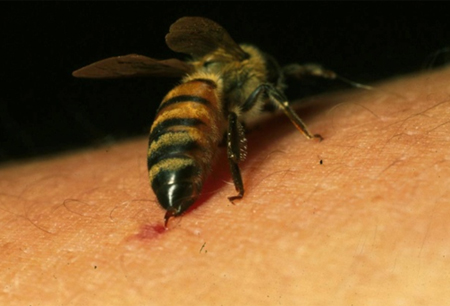 [Figure caption and citation for the preceding image starts]: Close-up of honeybee stingerCourtesy of Rick Vetter [Citation ends].
[Figure caption and citation for the preceding image starts]: Close-up of honeybee stingerCourtesy of Rick Vetter [Citation ends]. [Figure caption and citation for the preceding image starts]: Honeybee stinger anatomyCourtesy of Rick Vetter [Citation ends].
[Figure caption and citation for the preceding image starts]: Honeybee stinger anatomyCourtesy of Rick Vetter [Citation ends].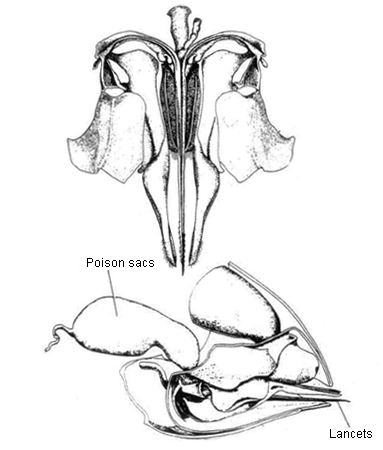
Medically important spider bites are the result of the spider defending itself. Bites most commonly come when the spider is being pressed or crushed against skin inadvertently. Black widow spiders often reside in dark corners of garages, tool sheds, cabinets, well houses, and other rarely used sites. Bites occur when people reach around blind corners and encounter the spider.[Figure caption and citation for the preceding image starts]: Black widow (Latrodectus species); the red hourglass marking is not always this shape and may not be presentCourtesy of Rick Vetter [Citation ends].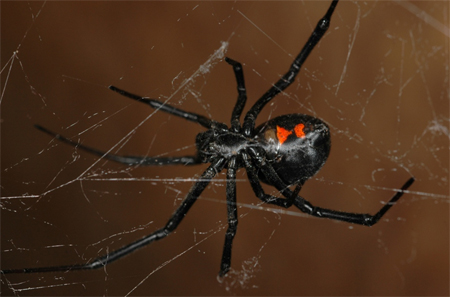 [Figure caption and citation for the preceding image starts]: Black widow (Latrodectus species)Courtesy of Bill Banner [Citation ends].
[Figure caption and citation for the preceding image starts]: Black widow (Latrodectus species)Courtesy of Bill Banner [Citation ends]. [Figure caption and citation for the preceding image starts]: Black widow (Latrodectus species)Courtesy of Bill Banner [Citation ends].
[Figure caption and citation for the preceding image starts]: Black widow (Latrodectus species)Courtesy of Bill Banner [Citation ends].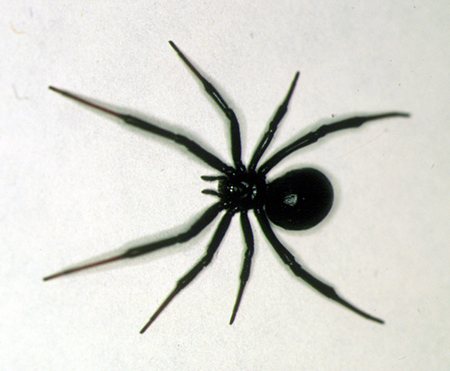 Recluse spiders prefer dry dark areas such as closets and trunks.[Figure caption and citation for the preceding image starts]: Brown recluse spider (Loxosceles species); note violin shape darker coloration on cephalothorax and 3 pairs of eyes at the base of the violinCourtesy of Rick Vetter [Citation ends].
Recluse spiders prefer dry dark areas such as closets and trunks.[Figure caption and citation for the preceding image starts]: Brown recluse spider (Loxosceles species); note violin shape darker coloration on cephalothorax and 3 pairs of eyes at the base of the violinCourtesy of Rick Vetter [Citation ends].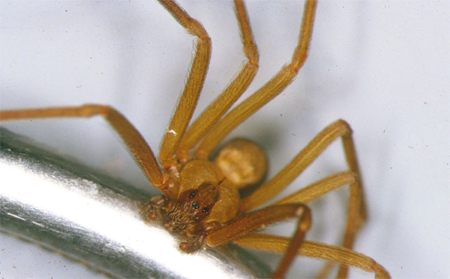 [Figure caption and citation for the preceding image starts]: Brown recluse spider (Loxosceles species)Courtesy of Rick Vetter [Citation ends].
[Figure caption and citation for the preceding image starts]: Brown recluse spider (Loxosceles species)Courtesy of Rick Vetter [Citation ends].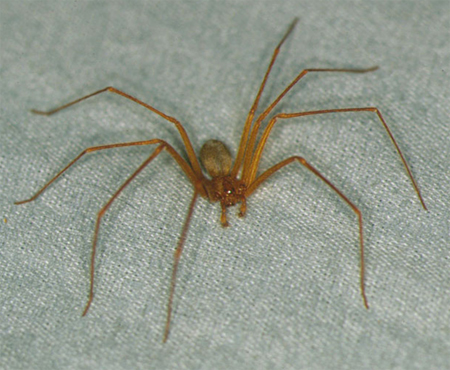 Spider bites commonly occur when putting on clothing containing a spider, and pressing the spider against the skin.
Spider bites commonly occur when putting on clothing containing a spider, and pressing the spider against the skin.
Pathophysiology
Venom components injected by stinging insects are more likely to produce severe reactions and anaphylactic responses than the salivary components of insect bites. Hymenoptera venom has been studied extensively.[19][20][21] There is significant similarity in the venoms from vespids including hornets, wasps, and yellow jackets. Patients with severe reactions to the stings of one of these insects have a high likelihood of sensitivity to the stings from another. Wasp venoms contain small molecules such as histamine, kinins and neurotoxins, and enzymatic proteins some of which are allergenic, including phospholipases A and B, and hyaluronidases. Honeybee venoms are immunochemically distinct from wasp venoms, and therefore sensitivity to one family does not imply sensitivity to the other. Honeybee venoms contain hyaluronidase, phospholipase A2, acid phosphatase, and melittin, as well as kinins and other vasoactive amines. Allergic reactions can result from sensitivity to any of these protein components. Disease transmission is unlikely from stings. The release of histamine, kinins, and other potent vasodilators in response to venom exposure accounts for the majority of local reactions, causing itching, burning, swelling, and pain.[Figure caption and citation for the preceding image starts]: Periorbital swelling 24 hours after yellow jacket sting above right eyeCourtesy of Tom Morrissey [Citation ends]. [Figure caption and citation for the preceding image starts]: Wheal formation following wasp stingCourtesy of Theodore Freeman [Citation ends].
[Figure caption and citation for the preceding image starts]: Wheal formation following wasp stingCourtesy of Theodore Freeman [Citation ends].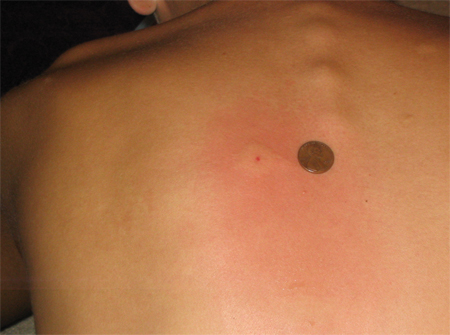 Immunoglobulin E (IgE)-mediated release of histamine and other mediators in severe reactions can result in hypotension, shock, and respiratory distress. The relatively high concentration of histamine receptors in the skin, lungs, and gastrointestinal mucosa leads to symptoms felt predominantly in these organ systems.[Figure caption and citation for the preceding image starts]: Pseudopustule formation following fire ant stingCourtesy of Theodore Freeman [Citation ends].
Immunoglobulin E (IgE)-mediated release of histamine and other mediators in severe reactions can result in hypotension, shock, and respiratory distress. The relatively high concentration of histamine receptors in the skin, lungs, and gastrointestinal mucosa leads to symptoms felt predominantly in these organ systems.[Figure caption and citation for the preceding image starts]: Pseudopustule formation following fire ant stingCourtesy of Theodore Freeman [Citation ends].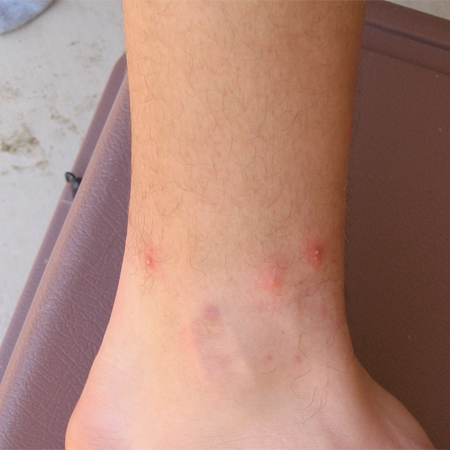 Fire ant stings contain only small amounts of venom in an unusual suspension of alkaloid toxins. These components cause localized tissue necrosis and the formation of a characteristic sterile pustule about 24 hours after the sting. This is not an infectious process and vesicles should be left intact. If opened, these lesions can serve as a portal for secondary infection. They should be kept clean and covered.[22][23] Fire ant venom contains protein allergens that can cause IgE antibody sensitization and lead to anaphylactic reactions to subsequent stings.
Fire ant stings contain only small amounts of venom in an unusual suspension of alkaloid toxins. These components cause localized tissue necrosis and the formation of a characteristic sterile pustule about 24 hours after the sting. This is not an infectious process and vesicles should be left intact. If opened, these lesions can serve as a portal for secondary infection. They should be kept clean and covered.[22][23] Fire ant venom contains protein allergens that can cause IgE antibody sensitization and lead to anaphylactic reactions to subsequent stings.
Black widow spider species venoms contain neurotoxins that cause presynaptic release of neurotransmitters including acetylcholine, norepinephrine, dopamine, glutamine, and enkephalins. Bites can cause effects both locally and systemically including pain, muscle cramps, diaphoresis, tremors, paresthesias, nausea/vomiting, and headache.[24] Autonomic instability can lead to profound hypertension and tachycardia.[25][26]
Recluse spider bites contain enzymes that cause local tissue destruction.[Figure caption and citation for the preceding image starts]: Lesions from reported brown recluse (Loxosceles species) envenomationCourtesy of Theodore Freeman [Citation ends].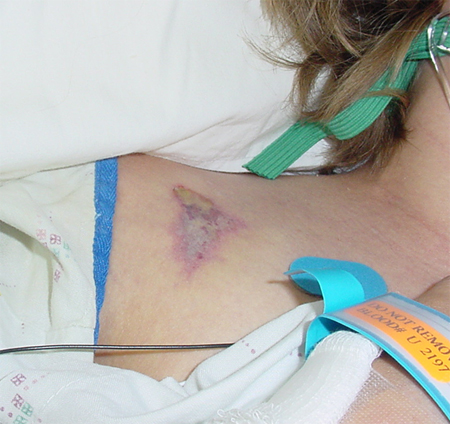 [Figure caption and citation for the preceding image starts]: Lesions from reported brown recluse (Loxosceles species) envenomationCourtesy of Theodore Freeman [Citation ends].
[Figure caption and citation for the preceding image starts]: Lesions from reported brown recluse (Loxosceles species) envenomationCourtesy of Theodore Freeman [Citation ends].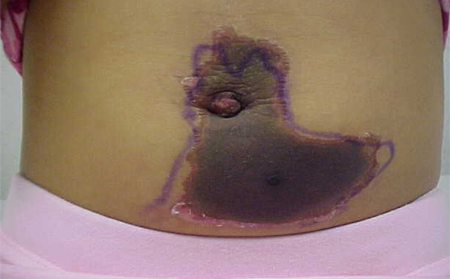 The enzyme sphingomyelinase D is thought to be the most clinically relevant. It is directly toxic to skin and tissue and activates degradative enzymes, complement components, and other inflammatory components. These wounds are at high risk of secondary infections.[25][27]
The enzyme sphingomyelinase D is thought to be the most clinically relevant. It is directly toxic to skin and tissue and activates degradative enzymes, complement components, and other inflammatory components. These wounds are at high risk of secondary infections.[25][27]
Anaphylaxis is an IgE-mediated hypersensitivity response to the exposure of an antigen in a presensitized individual.[1][3][28] Exposure to the antigen leads to rapid mast cell degranulation and release of histamine (and other vasoactive substances/kinins). This causes capillary leak and edema with myriad manifestations. Nonimmunologic reactions that are mediated by other mechanisms (i.e., reactions that are non-IgE-mediated) can occur after certain exposures and do not require pre-exposure or sensitization to cause symptoms.
Classification
Biological taxonomy
Insects are members of the class Insecta within the phylum Arthropoda. Insect bodies are divided into a head, thorax, and abdomen, and they have three pairs of legs.
Arachnids compose the class Arachnida, within the Arthropoda phylum, and are characterized by a two-segment body (cephalothorax and abdomen) and 4 pairs of legs. Spiders and ticks are different orders within the arachnid class.
Biting insects and arachnids
Common biting insects include mosquitoes, kissing bugs (assassin bugs), and some flies (including horseflies). Biting arachnids include ticks, black widow spiders (Latrodectus species) and recluse spiders (Loxosceles species). [Figure caption and citation for the preceding image starts]: Black widow (Latrodectus species); the red hourglass marking is not always this shape and may not be presentCourtesy of Rick Vetter [Citation ends]. [Figure caption and citation for the preceding image starts]: Brown recluse spider (Loxosceles species); note the violin shape darker coloration on cephalothorax and 3 pairs of eyes at the base of the violinCourtesy of Rick Vetter [Citation ends].
[Figure caption and citation for the preceding image starts]: Brown recluse spider (Loxosceles species); note the violin shape darker coloration on cephalothorax and 3 pairs of eyes at the base of the violinCourtesy of Rick Vetter [Citation ends].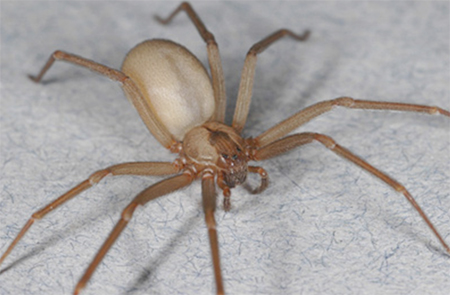
Stinging insects
Stinging insects belong to the order Hymenoptera. The most common culprit families include:
Bees (Apidae): bumblebees, Africanized honeybees ("killer bees"), domestic honeybees [Figure caption and citation for the preceding image starts]: Honeybee stinging fleshCourtesy of Rick Vetter [Citation ends].

Wasps (Vespidae): paper wasps, hornets, yellow jackets [Figure caption and citation for the preceding image starts]: Yellow jacketCourtesy of Rick Vetter [Citation ends].
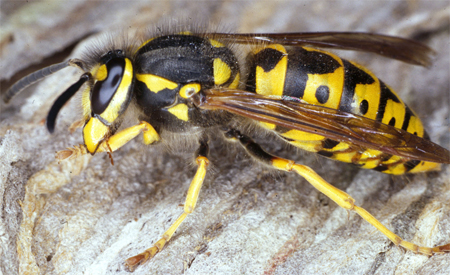
Ants (Formicidae): fire ants, harvester ants.
A honeybee can sting only once; the barbed stinger remains in the victim, and the bee eviscerates itself as it struggles to escape. Most other insects are capable of multiple stings, although some yellow jacket species more commonly lose their stingers. An Africanized honeybee sting is the same as a regular honeybee sting, but the more aggressive nature of the Africanized bees can lead to a swarm attack with large numbers of stings resulting in potentially life-threatening toxic reactions.
Reaction to bite or sting
Local reactions
There may be localized irritation or swelling to physical or chemical properties of the bite or sting.
Large local reactions
Localized swelling caused by IgE-sensitivity to allergenic components of the bite or sting develops progressively after 6-12 hours, peaking after 2-3 days and subsiding after 3-10 days. Intense local inflammation can cause a lymphangitic streak that does not represent infection.
Systemic reactions
Can be toxic (delayed, usually after a very large number of stings) or allergic (usually immediate).
Allergic systemic reactions can be limited to the skin (itching, hives, swelling, flushing) or can involve multiple organ systems (anaphylaxis).
Life-threatening anaphylactic reactions are rare, but require prompt treatment to avoid serious outcomes.
Anaphylaxis is likely when any one of the following three criteria is satisfied:[1][2][2][3][4][5]
Acute onset of a reaction that involves the skin, mucosal tissue, or both with either respiratory involvement or reduced blood pressure and/or associated symptoms of end-organ dysfunction
Two or more of the following occur rapidly after exposure to a likely allergen: involvement of skin-mucosal tissue, respiratory involvement, reduced blood pressure or associated symptoms, or gastrointestinal symptoms
Reduced blood pressure after exposure to a known allergen.
Injected epinephrine is the mainstay treatment of severe reactions. There are no absolute contraindications to epinephrine treatment in severe reactions.
Secondary infection
Infection at the site of a bite or sting is rare and would be delayed in onset.
This is not inflicted by the insect, but a result of the breakdown of the normal skin barrier.
Disease transmission
Mosquito bites may transmit malaria, dengue fever, yellow fever, Zika virus, and some forms of encephalitis.
Tick bites may transmit Lyme disease and Rocky Mountain spotted fever.
Serum sickness
Although uncommon, this delayed reaction may occur about 1 week after envenomation.
Symptoms include fever, myalgias, arthralgias, rash, adenopathy, and headache. Very rarely, vasculitis and immunologic complications can lead to glomerulonephritis, Guillain-Barre syndrome, hemolytic anemia, thrombotic thrombocytopenic purpura, transverse myelitis, optic neuritis, and other neuropathies.[6][7][8][9]
Galactose-alpha-1,3-galactose (alpha-gal) allergy
Galactose-alpha-1,3-galactose allergy (tick borne) results in urticaria, angioedema, or anaphylaxis 3-6 hours after ingestion of mammalian meats (e.g., beef, pork, lamb).
Multiple tick bites appear to result in sensitization.
The tick species most commonly implicated in the US is the lone star tick (Amblyomma americanum).[10] Other species have been implicated in other parts of the world.
Use of this content is subject to our disclaimer